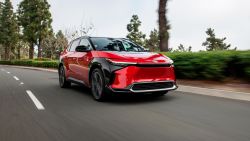As recently as December 2016, the massive and proud General Motors plant in Lordstown, Ohio, was running three work shifts a day, employing more than 3,000 hourly workers making the Chevrolet Cruze. GM made about 190,000 of the compact sedans that year.
Then Americans lost their taste for sedans, demand for the Cruze dried up, and GM started eliminating shifts at Lordstown. The factory built its final car in March 2019.
The plant was idled and the lives of the remaining 1,400 GM employees were uprooted.
Today Lordstown is a central issue in an ongoing labor strike by nearly 50,000 GM workers. The fate of the plant — and the people who might work in it again — underscores the difficult issues facing America’s biggest car maker as well as the United Auto Workers, the union that has represented generations of American autoworkers.
Century-old General Motors, like the auto industry as a whole, is attempting a dramatic business reinvention. It’s moving from cars driven by people to self-driving vehicles. From selling cars to selling rides like Uber does. And its evolving from a company that makes cars fueled by gasoline into one that specializes in electric vehicles that run on batteries.
Who will make those batteries is a sticking point in the strike, which began on September 16.

The union has made bringing the Lordstown plant back to life a key goal of the negotiations. The problem is GM says it doesn’t need it to make the traditional sedans it once made.
Instead, according to a person familiar with GM’s offer to the union, the company is proposing to build large lithium batteries — the kind used in electric vehicles — on the Lordstown property or at a different, nearby facility. GM said its offer to the UAW included the “opportunity to become the first union-represented battery cell manufacturing site in the US.”
While negotiations continued on Thursday, it was apparent the union wasn’t particularly excited about the plan to replace Lordstown with a battery factory. It instead wants GM to shift some vehicle production it had moved to Mexico back to Lordstown.
Salaries are a contentious question. Another person familiar with GM’s offer said the company wants to pay significantly less for the battery jobs than it did for the old Lordstown assembly jobs — about $15 to $17 an hour versus more than $30 an hour on average.
Most plants in North America that make lithium car batteries, including those owned by non-union supply companies and the massive Gigafactory that Tesla operates in Nevada, pay in that $15 to $17 an hour range. The batteries are a major part of the cost of building and electric car. GM believes it needs batteries at a competitive cost if it’s going to succeed in the electric car market.
The union is also concerned because it believes the shift to electric cars could mean fewer jobs, said Kristin Dzcizek, vice president of industry, labor & economics at the Center for Automotive Research, a Michigan think tank.
Battery plants are highly automated, able to turn out batteries with relatively few workers, she said. In addition the electric cars they go into have fewer moving parts than do traditional cars with internal combustion engines. Fewer moving parts mean fewer workers on the assembly line.
On the other hand, UAW has the opportunity to represent GM employees doing the kind of work the company will need to do more of in the future.
“It’s not whether the jobs are worth $15 or $17 or $30 an hour,” Dzcizek said. “It’s a matter of do you have a job at all, or do you not have those jobs be represented by the union. That’s what they’ve been faced with.”
Even as GM and other auto makers shift more of their production, it will probably be decades before electric vehicles make up a majority of new car sales. But the shift has begun, and both the company and union know it, Dziczek said. That’s what makes the future of Lordstown so important in the talks to end the strike.

























